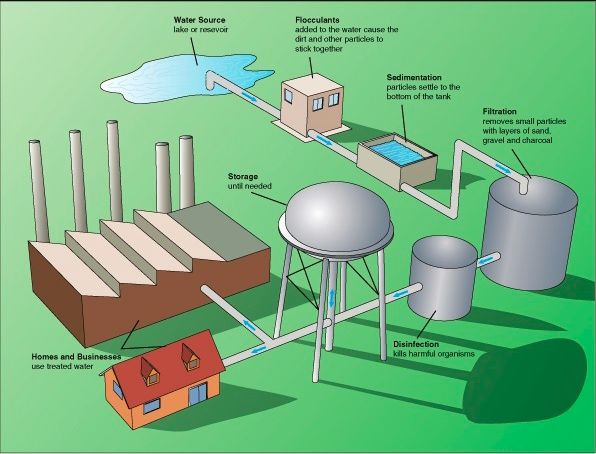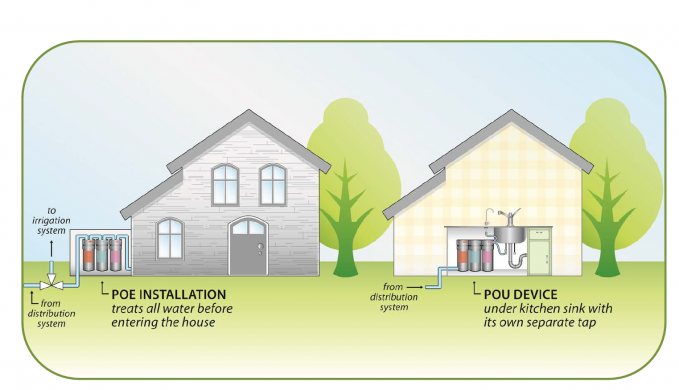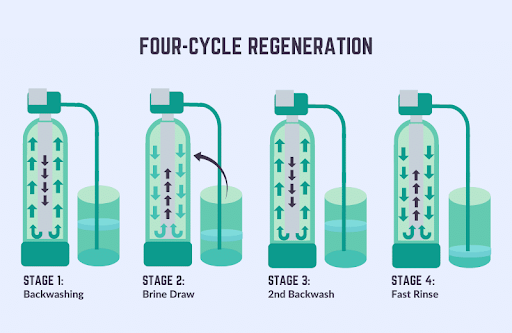Understanding Centralized vs Decentralized Treatment in Public Water Systems
Clean water is an essential basic human need.
However, along with rapid population growth and urbanization, the provision of safe and sustainable clean water is a major challenge in many countries, including Indonesia. Public water treatment systems play a crucial role in ensuring the availability of clean water for the wider community. In this article, we will take an in-depth look at public water systems, specifically comparing centralized and decentralized water treatment approaches.
Public water systems include the entire infrastructure and processes used to collect, treat, and distribute clean water to the public. This includes water sources (such as rivers, lakes, or groundwater), water treatment facilities, distribution pipelines, and end-use points at homes and buildings. The ultimate goal is to provide water that is safe, clean, and meets quality standards for consumption.
Before we go further into centralized and decentralized treatment systems, it is important to understand some basic concepts in water treatment. The water treatment process generally involves a few key stages:
- Initial filtration to remove large particles
- Coagulation and flocculation to agglomerate small particles
- Sedimentation to settle the agglomerated particles
- Filtration to filter out smaller particles
- Disinfection to kill pathogenic microorganisms
In addition, depending on the quality of the source water and applicable standards, additional processes may be required such as aeration, iron and manganese removal, pH adjustment, or the use of activated carbon to remove odor and taste.
Now, let's discuss the water quality of the source water.
Now, let's discuss in more detail about the two main approaches in public water treatment systems: centralized and decentralized.
Centralized Water Treatment System

Centralized water treatment systems are a traditional approach that has long been used in many major cities around the world, including in Indonesia. In these systems, water from a primary source (usually a large river or lake) is treated at one large-scale water treatment facility, then distributed throughout the service area via an extensive network of pipes.
The main advantages of centralized systems are:
- Economies of scale efficiency: Large amounts of treatment can be more cost-effective per unit of water produced.
- Consistent quality control.
- Consistent quality control: With one main treatment point, it is easier to monitor and maintain consistent water quality.
- Consistent quality control.
- Ability to handle demand fluctuations: Large facilities can better cope with seasonal or daily changes in demand.
- Ability to handle demand fluctuations.
However, centralized systems also have some disadvantages:
- Risk of widespread disruption: In the event of a problem at a key facility, the entire system can be disrupted.
- Centralized distribution network.
- Water loss in distribution: The farther the water has to be distributed, the greater the potential for leakage and water loss.
- Water loss in distribution.
In Indonesia, many large cities such as Jakarta, Surabaya, and Medan rely on centralized water treatment systems. However, challenges such as rapid population growth, aging infrastructure, and limited water resources often overwhelm these systems.
Centralized Water Treatment System

As an alternative or complement to centralized systems, decentralized water treatment approaches are receiving increasing attention. In these systems, water treatment is carried out in several smaller, dispersed facilities closer to the point of use.
The advantages of decentralized systems include:
- Flexibility: More adaptable to local needs and can be scaled up incrementally.
- Flexibility.
- Resilience: If one unit has a problem, the impact is limited and does not affect the entire system.
- Distribution efficiency.
- Distribution efficiency: Reducing distribution distance reduces water loss and pumping costs.
- Distribution efficiency.
- Local resource utilization: Can utilize local water sources such as groundwater or rainwater.
- Local resource utilization.
However, decentralized systems also have challenges:
- Management complexity: Managing many small units can be more complicated than one large facility.
- Quality consistency: Ensuring the same quality standards across all units can be challenging.
- Consistency of quality.
- Human resource requirements: May require more trained operators to manage multiple units.
In Indonesia, decentralized approaches are gaining popularity, especially in areas not yet covered by centralized systems. For example, the use of community-scale water treatment systems in rural or suburban areas.
Comparison and System Selection Considerations
Choosing between centralized and decentralized systems, or a combination of both, depends on various factors:
- Geography and topography of the region
- Availability and quality of water sources
- Population density and growth patterns
- Existing infrastructure
- Financial and technical resources
- Government policies and regulations
In many cases, a hybrid approach that combines centralized and decentralized elements may be the optimal solution. For example, a large city may have a main centralized system, complemented by decentralized treatment units in peripheral or hard-to-reach areas.
Technology and Innovation in Water Treatment
Technological advancements continue to bring innovations in water treatment, both for centralized and decentralized systems. Some of the increasingly important technologies include:
- Filtration membranes: Technologies such as ultrafiltration and reverse osmosis are increasingly efficient and affordable.
- Membrane filtration.
- UV disinfection: An effective method to kill pathogens without chemicals.
- UV disinfection.
- Automated systems: Use of sensors and automated controls for process optimization.
- Automated systems.
- Stormwater and wastewater treatment technologies: Improves utilization of alternative water resources.
In Indonesia, the adoption of these technologies is increasing. For example, the use of household-scale reverse osmosis systems is gaining popularity in areas with poor water quality.
Challenges and Solutions in Public Water Systems in Indonesia
Indonesia faces several specific challenges in water supply:
- Poor quality of water sources: Many rivers and lakes are polluted by industrial and household effluents.
- Poor water quality.
- Aging infrastructure: Many water treatment and distribution systems are old and inefficient.
- Infrastructure aging.
- Rapid population growth: Especially in urban areas, leading to increased water demand.
- Geographic variation.
- Geographic variations: Different conditions between islands and regions require different approaches.
- Geographic variations.
To address these challenges, some solutions implemented or considered include:
- Infrastructure upgrades: Investment in renewal and expansion of water treatment systems.
- Diversification of water sources: Including groundwater utilization, seawater desalination, and rainwater treatment.
- Community-based approaches.
- Community-based approach: Involving local communities in the management of small-scale water systems.
- Community-based approaches: Involving local communities in the management of small-scale water systems.
- Public-private partnerships: Increasing efficiency and investment in the water sector.
One example of innovation is the use of ultraviolet systems for water disinfection in remote areas that do not have access to disinfectant chemicals.
The Role of Technology in Household Water Treatment
In addition to public water systems, water treatment at the household level is also becoming increasingly important in Indonesia. Many households use a combination of water from municipal systems and wells, which is then further treated to ensure its safety and quality.
Household water treatment systems generally use a combination of municipal systems and wells.
Household water treatment systems generally involve several stages:
- Storage: Using storage tanks for municipal or well water.
- Pumping: Using a pump to distribute water throughout the house.
- Pumping.
- Filtration: Using filters to remove particles and contaminants.
- Filtration.
- Utilization: Using a water softener to reduce water hardness.
- Utilization.
- Disinfection: Using chlorine, UV, or other technologies to kill bacteria.
- Disinfection.
For homes with specific water quality issues, such as high levels of iron or manganese, specialized treatment systems such as iron removal filters may be needed.
Conclusion
Public water systems, both centralized and decentralized, play a vital role in providing clean water to communities. In Indonesia, with its diverse geographical and demographic challenges, flexible and innovative approaches are needed to ensure sustainable access to clean water for the entire population.
A combination of public infrastructure improvements, centralized and decentralized water systems may play a vital role in providing clean water to communities.
A combination of improved public infrastructure, adoption of new technologies, and empowerment of communities in local water management will be key in meeting future water challenges. With the right investments and supportive policies, Indonesia can move towards a more resilient, efficient and sustainable water system.
As individuals, we are also individuals.
As individuals, we also have an important role to play in conserving water and supporting responsible water management. By understanding public water systems and actively participating in source water protection efforts, we can contribute to long-term water security for future generations.
Questions and Answers
1. Why is chlorine odor in drinking water actually a positive sign?
The smell of chlorine in drinking water is actually a positive indication that the water has gone through an effective disinfection process. Chlorine is used widely in water treatment because of its powerful ability to kill harmful bacteria and microorganisms. While some people may not like the smell, the residual presence of chlorine in water indicates that the water has been properly disinfected and is safe to drink. In many countries, including some parts of Indonesia, people actually prefer water with a slight chlorine odor as they consider it a sign of safe and clean water.
2. What are the main differences between centralized and decentralized water treatment systems?
The main difference between centralized and decentralized water treatment systems lies in the scale and location of treatment. Centralized systems treat large amounts of water at one main facility and distribute it through an extensive network of pipes. Decentralized systems, on the other hand, consist of several smaller, dispersed treatment units closer to the point of use. Centralized systems are generally more efficient for dense urban areas, while decentralized systems are more flexible and suitable for more dispersed or remote areas.
3. How does reverse osmosis (RO) technology help in household water treatment?
Reverse osmosis (RO) technology is highly effective in removing various contaminants from water, including dissolved salts, bacteria, and chemicals. In household water treatment, RO systems such as the Pentair Merlin Undersink Reverse Osmosis can be installed under the sink to produce high-quality drinking water. These systems are especially useful in areas with poor water quality or high TDS (Total Dissolved Solids) content. RO can remove up to 99% of contaminants, making it a popular choice for ensuring drinking water safety in households.
References
1. Binnie, C., & Kimber, M. (2013). Basic Water Treatment (5th Edition). ICE Publishing.
"The adoption of extensive new physical and chemical water-quality standards, which apply at the point of delivery to the consumer, has meant not only additional water treatment, but also the close examination of water-distribution systems, to ensure that the water entering the distribution system does not deteriorate unacceptably as it travels to the point of use." (p. 11)
2. Spellman, F. R. (2013). Handbook of water and wastewater treatment plant operations. CRC Press.
"Conventional water treatment model, Screening, Flocculation, Settling tanks, Sand filters, Sludge processing, Disinfection, Chemical oxidation of iron and manganese, sulfides, taste- and odor-producing compounds, and organic precursors, Adsorption for removal of tastes and odors" (p. 630)
3.
3. Byrne, W. (2002). Reverse osmosis: A practical guide for industrial users. Tall Oaks Publishing.
"The passage provides a comprehensive summary of common water and wastewater treatment topics related to reverse osmosis (RO) systems. It discusses the potential issues with iron, manganese, aluminum, copper, zinc, sulfides, and phosphates in RO feedwater, and how to address them." (p. 20)
4. Hendricks, D. W. (2006). Fundamentals of water treatment unit processes: physical, chemical, and biological. CRC Press.
"The passage provides a comprehensive summary of the disinfection by-products (DBPs) issue in water treatment, including the history, research, and impact on the drinking water industry." (p. 81)

.png?width=50&height=50&name=Logo_Watermart_Perkasa-removebg-preview%20(1).png)


.jpg?width=352&name=plumber-change-water-filter_255667-59293%20(1).jpg)